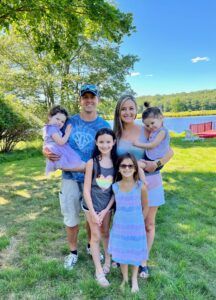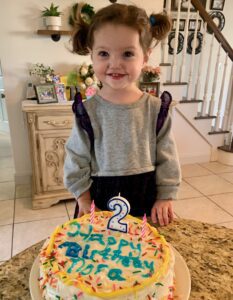In the first year after her daughter Nora’s Shwachman-Diamond syndrome (SDS) diagnosis, and her daughter Kayla’s subsequent diagnosis, Lisa Superina raised over $130,000 towards SDS research. She held a comedy show, casino night, cookie sales, fall festival, and even a psychic medium night. But most of all, she talked to anybody who would listen. Lisa shares:
A lot of people are quiet about rare diseases or don’t know how to talk about it. I’m not. I wear my SDS clothes everywhere. I reach out to local organizations. I start conversations with anybody who is open to talking about it. Finding cures and treatments for rare diseases cost millions. These little moments of awareness and advocacy add up. In the end, I want to help my daughters and I will do anything to do that.
Her experience on this path has not always been easy. Lisa still remembers the very beginning of her journey into rare disease: sitting up until 3am looking up keywords online to try and figure out what was going on. As she fervently typed in “poor weight gain” and “excessive stools,” she scrolled through results looking for something—anything—that she could use to help her children. She says:
The problem with rare diseases is that nobody thinks of them. My daughter fits SDS to a T, but it wasn’t on any of our radars.
That is why Lisa is so dedicated to sharing her family’s story, to raising awareness, and to spreading an understanding of Shwachman-Diamond syndrome on a greater scale. She wants other people to know that they aren’t alone just as much as she wants doctors to keep rare diseases in mind.
Recently, Lisa spoke with Patient Worthy about her family’s story, what Shwachman-Diamond syndrome is, how the girls are doing today, and advice for other families on their journey.
Nora’s Story
Lisa and her husband, Graig, have been married for eleven years. Over that time, they built a full and loving life together. They welcomed daughters Maria (9), Emma (7), Kayla (4), and Nora (2)—all spring babies with beautiful smiles.

But Nora’s journey seemed more uncertain than the rest. Although Nora was a happy baby, she was also very sickly. She was born March 16, 2020 right before everything shut down. Over her first few months of life, Nora was small, weak, and fatigued; she struggled to gain weight and had bags under her eyes. She almost seemed malnourished, despite the fact that she could nurse all day long. Says Lisa:
I knew there was something going on but everyone around me kept telling me to wait it out, that she would grow. My mom, who is a nurse, agreed with me. She said Nora seemed hypotonic and we needed to ask for bloodwork.
The pediatrician agreed to bloodwork at Nora’s six month appointment. This was the first time where Nora had fallen off of her growth curve. Her bloodwork showed that Nora had elevated liver enzymes. The pediatrician referred the family to a GI doctor who checked Nora for cystic fibrosis, Celiac disease, and a variety of liver and autoimmune diseases. All of the tests were negative. The family was then referred to a hepatologist, endocrinologist, and geneticist. Lisa shares:
This was right in the middle of COVID-19, so appointments were difficult to get. Some specialties, like genetics, weren’t considered ‘priority’ so getting the appointment was so hard. I was first told that there were no genetic appointments available for four months. I could not accept this, I just had to keep calling and advocating for my child.
Exploring the Genetics Angle
Eventually, Lisa was able to connect with a geneticist who performed additional bloodwork and sent test kits in the mail. Once again, however, the search seemed fruitless. The DNA microarray showed nothing. So the family went to the next step: whole exome sequencing and disease-specific testing. Lisa explains:
Doctors were searching for metabolic or mitochondrial diseases. Shwachman-Diamond syndrome was not on anybody’s radar. Even the whole exome sequencing came back completely negative. We later found out this was due to a nearby pseudogene. At that point, the doctors pretty much told me that we had to just wait and see.
Lisa was exasperated. She was watching her daughter become weaker and more malnourished before her eyes, but nothing seemed to help. Nora’s liver enzymes climbed into the thousands. A biopsy showed liver fat and fibrosis. In addition to multiple respiratory infections, Nora had pneumonia twice in the first year. She had excessive, pale, and awful smelling stools. She had skin infections, eye infections, ear infections. Says Lisa:
Every time she got sick, I wondered if that was it. If I was going to lose my daughter. She did not respond to illness the way most children would and I was terrified.

Lisa only became more doggedly committed to finding an answer. She pushed doctors to perform stool tests and they did a fecal fat (negative). Looking back, the process was more frustrating and stilted than it needed to be. She explains:
The doctors did not do a fecal elastase test, which checks how nutrients are absorbed in the pancreas. This kills me because Nora had low pancreatic enzymes. Cystic fibrosis and Shwachman-Diamond syndrome are two of the biggest causes for exocrine pancreatic insufficiency. If they had checked that early on, we may have had a different trajectory. But I didn’t know to ask for that.
Finally, Lisa asked the geneticist if there was anything else that could be done. Any other tests, any other ideas. The geneticist, after careful consideration, offered whole genome sequencing. This came with a warning: that it was only a 5% yield from the whole exome sequencing. 5% was enough for Lisa.
And she was correct. There was something going on with Nora. This was the test that needed to be run. After a tough journey, the family finally received the diagnosis of Shwachman-Diamond syndrome (SDS).
Join us in Part 2 as we discuss what Schwachman-Diamond syndrome is, a diagnostic shock, how Lisa’s daughters are doing today, and Lisa’s continued push for SDS awareness.






